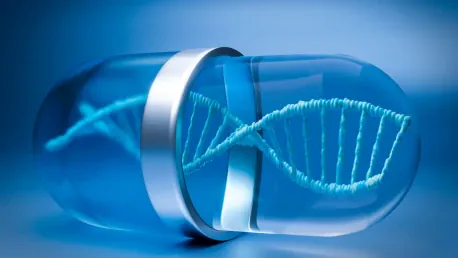Gene therapy has emerged as a promising frontier for treating a range of genetic disorders, but effectively delivering therapeutic genes to the kidneys remains a significant challenge. Researchers at the Oregon Health & Science University School of Medicine have been delving into the complex domain of “context-dependent selection of AAV capsids” to refine gene delivery methods. This cornerstone research sheds light on novel strategies for using adeno-associated virus (AAV) vectors to combat kidney diseases, providing hope for realistic and groundbreaking treatments.
Context-Dependent Selection of AAV Capsids
Local Delivery Versus Systemic Delivery
One of the primary revelations of the study was the distinct impact of delivery routes on gene transfer efficiency. Local delivery of AAV-KP1 via the renal vein or pelvis was found to be particularly effective in transducing proximal tubules. This method also boasts the advantage of minimal off-target transduction to other organs, such as the liver, unlike what is observed with AAV9. This discovery is crucial because it means that AAV-KP1 can be more precisely targeted, minimizing potentially harmful side effects and increasing the efficiency of therapeutic interventions.
Conversely, the study found that systemic delivery of AAV9 favored enhanced transduction in both proximal tubules and podocytes, especially pertinent to chronic kidney disease. This route still has beneficial implications for broader systemic therapies entailing AAV9. These divergent outcomes underline the importance of selecting the appropriate AAV capsid and delivery method tailored to the specific condition being treated. Factors like the patient’s health status, the severity of kidney disease, and the targeted kidney structures all play pivotal roles in optimizing these treatments.
Implications of Pharmacokinetics on Gene Delivery
The differences in performance between AAV-KP1 and AAV9 are attributable to their distinct pharmacokinetics. Pharmacokinetics, the study of how drugs move through the body, significantly influences the absorption, distribution, and elimination of AAV vectors. The localized delivery method used with AAV-KP1 ensures that therapeutic genes remain concentrated in the kidney, rather than spreading to other organs. This focused approach can lead to a higher success rate in gene therapy, particularly concerning localized kidney disorders.
The systemic use of AAV9 illustrates how varying the delivery route can change the dynamics of gene distribution. Higher transduction rates in specific kidney cells (proximal tubules and podocytes) suggest that systemic administration might be more suitable for conditions involving widespread kidney damage. The intrinsic pharmacokinetic properties of each AAV capsid suggest the need for a personalized approach to therapy, leveraging the unique attributes of different AAV vectors to maximize therapeutic impact while minimizing off-target effects.
Tailored Approaches in Gene Therapy
Addressing Pre-Existing Immunity
Another critical consideration in the success of AAV-mediated gene therapy is pre-existing immunity. Researchers utilized a barcode-seq-based comparison of 47 AAV capsids, which were administered through various routes in mice. By following this with individual validation, they successfully identified that renal pelvis injection could effectively bypass pre-existing immunity. This route of administration allowed for robust proximal tubule transduction in non-human primates (NHPs), a promising development for the potential application in human therapies where pre-existing immunity challenges are a concern.
The kidney’s unique immunological environment requires carefully tailored gene therapy approaches. Addressing pre-existing immunity is particularly significant as prior exposure to certain AAV capsids might undermine the effectiveness of new treatments. The research highlights how specific AAV capsids, combined with tailored delivery routes like renal pelvis injection, can overcome immunological barriers and enhance the efficacy of gene therapy.
Differences in Renal Transduction Between Species
One essential point noted by the researchers is that the renal transduction profiles can differ significantly between species. In this study, notable disparities in gene transduction efficiency were observed between mice and non-human primates. This suggests that animal models currently used in preclinical testing might not fully replicate the human biological context. Therefore, there’s a need to validate these findings extensively in NHPs or other species closer to humans in anatomy and physiology before transitioning to human clinical trials.
Moreover, the study underscored considerable differences in renal transduction between healthy and diseased kidneys. Recognizing these disparities emphasizes that the success of gene therapy isn’t uniform but heavily contingent on the patient’s condition. The findings stress the need for precise, context-dependent selection of AAV capsids and administration routes. This adaptability might provide the best outcomes for diverse patient profiles, ensuring that therapeutic gene interventions are both safe and effective for those suffering from various kidney diseases.
Future Implications and Next Steps
Personalized Gene Therapy Strategies
This groundbreaking research into the selection of AAV capsids and delivery methods represents a significant advance in overcoming the barriers of gene therapy for kidney diseases. The insights gained here into the pharmacokinetic behaviors of AAV9 and AAV-KP1, and the importance of tailored approaches, open avenues for more effective and targeted treatments. Future research will need to focus on refining these methods and exploring other capsids and administration routes that could further improve gene delivery efficiency.
The need for personalized gene therapy strategies is highlighted by these findings. Not all patients will respond similarly to a given treatment, especially considering the variety of genetic kidney diseases. Thus, these new insights pave the way for highly individualized treatment plans that take into account the patient’s specific condition, genetic background, and immunological profile.
Potential for New Treatments
Gene therapy has become a promising avenue for treating various genetic disorders, yet successfully delivering therapeutic genes to the kidneys remains a significant challenge. At the Oregon Health & Science University School of Medicine, researchers are exploring the intricate field of “context-dependent selection of AAV capsids” to improve gene delivery techniques. AAV, or adeno-associated virus vectors, are being investigated as vehicles to ensure the effective targeting and transfer of genes to kidney cells. This foundational research provides new insights and strategies for using AAV vectors in the fight against kidney diseases, offering genuine hope for pioneering and effective treatments. The detailed study aims to overcome the barriers that have historically hindered the success of gene therapy in renal applications. With these innovative approaches, there is potential for significant advances in treating kidney conditions that currently have limited options. The work being done holds promise for the development of new, effective, and lasting solutions for those suffering from kidney-related genetic disorders.









